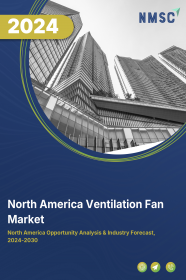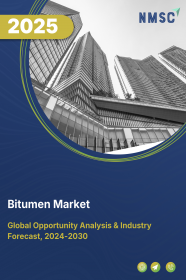
North America Ventilation Fan Market by Product Type (Centrifugal Fans, Axial Fans, Hatch Fans, and Duct Fans), by Flow Rate (Below 100 CFM, 100-250 CFM, 250-500 CFM, 500-750 CFM, and Above 750 CFM), by Material (Metal and Plastic), by Installation (Ceiling Mounted, Wall Mounted, and In line installation), by Application (Industrial, Commercial, and Residential), and by Distribution Channel (Online and Offline)– Opportunity Analysis and Industry Forecast, 2024–2030
Industry: Construction & Manufacturing | Publish Date: 05-Apr-2024 | No of Pages: 147 | No. of Tables: 104 | No. of Figures: 69 | Format: PDF | Report Code : N/A
US Tariff Impact on North America Ventilation Fan Market
Trump Tariffs Are Reshaping Global Business
Market Definition
The North America Ventilation Fan Market size was valued at USD 705.5 million in 2023, and is predicted to reach USD 1153.2 million by 2030, at a CAGR of 6.7 % from 2024 to 2030.
A ventilation fan is a crucial component that enhances air circulation within enclosed spaces, resulting in better air quality and regulation of temperature and humidity levels. These fans are essential for creating favourable working environments and are widely used in various settings such as factories, warehouses, offices, and commercial spaces. Their main functions include removing stagnant air, regulating moisture levels, and reducing harmful pollutants, thus promoting a safe and comfortable atmosphere for occupants. Acknowledged for their significant role in improving workplace productivity and ensuring compliance with health and safety regulations, ventilation fans are considered indispensable assets for enterprises across different industries.
Increasing Government Regulations and A Focus on Energy Efficiency are Driving up the Demand for Ventilation Fans
The ventilation fan market is being driven by the implementation of stringent building regulations and energy efficiency standards enforced by governments worldwide. These regulations emphasize the importance of maintaining indoor air quality (IAQ) while reducing energy consumption in residential, commercial, and industrial buildings.
As a result, building codes and standards increasingly mandate the installation of ventilation fans to ensure adequate airflow and the removal of pollutants. Simultaneously, there is a significant emphasis on energy-efficient building practices, compelling ventilation fan manufacturers to develop products that meet or exceed energy efficiency benchmarks.
This drive has led to the introduction of innovative technologies such as energy-efficient fan motors, advanced airflow designs, and integrated control systems. Consequently, there is a growing demand for ventilation fan solutions that not only enhance indoor air quality but also minimize energy usage and operational expenses, thereby fueling the growth of the ventilation fan market.
The Increasing Awareness of Indoor Air Quality Fuels the Growth of the Market
The surge in the ventilation fan market is driven by an increasing awareness of indoor air quality (IAQ) among consumers. Heightened concerns about the health effects of indoor air pollution are prompting individuals to acknowledge the crucial role of proper ventilation in various indoor settings, including homes, offices, and commercial establishments.
This heightened awareness is driving demand for ventilation fans equipped with advanced filtration systems and efficient airflow management features to effectively combat indoor air contaminants. Consumers actively seek solutions capable of improving IAQ by removing pollutants, allergens, and odors from the air, thus promoting healthier and more comfortable indoor environments.
Consequently, manufacturers are responding to this demand by developing ventilation fan products that prioritize IAQ enhancement, leading to the expansion of the ventilation fan market as it aligns with the evolving preferences and concerns of consumers regarding indoor air quality.
High Expenses Related to the Maintenance and Installation of Ventilation Fan Hinders the Growth of the Market
The substantial expenses associated with elevator installations, maintenance, and upgrades are significant barriers hindering market growth. The initial investment needed for installing elevator systems, especially in buildings not originally designed for such infrastructure, can impose a substantial financial burden on building owners and developers.
Additionally, ongoing costs related to maintenance contracts, including regular inspections and repairs, add to the overall ownership expenses. Furthermore, the need for modernization to meet updated safety standards and improve energy efficiency further amplifies the financial strain.
These expenditures can be particularly challenging for building owners in regions with limited financial resources or older buildings where retrofitting elevators is complex and costly. Consequently, the high costs associated with elevators impede market expansion, impacting growth prospects across various regions.
The Growing Attention Towards Energy Efficiency Regulations Presents Opportunities for The Future
As energy efficiency standards are tightened by governments and regulatory bodies, there is a rising demand for ventilation fan solutions that surpass these regulations. This emerging trend offers substantial opportunities for manufacturers to lead in developing energy-efficient products.
Firms capable of meeting these rigorous standards are in a favorable position to enhance their market influence by offering solutions that not only align with evolving regulations but also resonate with environmentally conscious consumers and businesses. This strategic edge places them ahead of compliance necessities and enables them to seize a larger market segment.
The U.S. Holds the Dominant Market Share in North America Ventilation Fan Market
The ventilation fan market in the U.S. is driven due to a combination of regulatory measures and increased awareness of indoor air quality (IAQ). Regulations and initiatives such as the Energy Star program, the Indoor Air Quality Act, and local building codes play pivotal roles in shaping this market.
The Energy Star program, with its energy efficiency standards for ventilation fans, encourages manufacturers to enhance their products, promoting the adoption of energy-efficient ventilation solutions. Similarly, the Indoor Air Quality Act emphasizes the importance of safe and healthy indoor environments, indirectly encouraging the improvement of air quality through ventilation systems.
Moreover, adherence to local building codes and health regulations across states influences ventilation fan adoption, reinforcing the demand for compliant and high-quality ventilation solutions nationwide. These regulatory frameworks and initiatives collectively drive the growth of the ventilation fan market in the United States, ensuring the provision of efficient and safe indoor air ventilation across residential, commercial, and industrial sectors.
Furthermore, heightened awareness of IAQ serves as a significant driving factor in this market. The Environmental Protection Agency (EPA) of the United States has set indoor guidelines for radon, and several states have established IAQ guidelines, including recommendations for carbon dioxide levels, carbon monoxide levels, and exposure to environmental tobacco smoke (ETS). Growing concerns about airborne pollutants, allergens, and health risks associated with poor IAQ are fueling demand for solutions, including ventilation fans.
Additionally, the prevalence of asthma and other respiratory illnesses underscores the critical need for proper ventilation in homes and buildings to mitigate health risks and improve indoor air quality. This increased awareness of IAQ drives the adoption of ventilation fans across residential, commercial, and industrial sectors, ensuring healthier and safer indoor environments for occupants nationwide.
Mexico to Witness Substantial Growth in the North America Ventilation Fan Market
The ventilation fan market in Mexico is driven by rapid urbanization and continuous construction in residential, commercial, and industrial areas. Business Monitor International (BMI) projects a rebound in the construction sector following a decline of 17.6 percent in 2020, with a forecasted growth of 0.4 percent in 2022 and 1.1 percent in 2023.
An average annual growth rate of 2.8 percent is anticipated between 2023 and 2032. As urban expansion and new construction projects progress, there is a consistent demand for ventilation systems to ensure proper airflow and maintain indoor air quality.
Ventilation fans are becoming increasingly essential in providing occupants with comfortable and healthy indoor environments. Moreover, Mexico's diverse climate, ranging from hot and humid to dry climates, highlights the significance of adequate ventilation solutions, further boosting market growth. Ventilation fans play a crucial role in regulating indoor temperature and humidity levels, enhancing indoor air quality, and overall comfort for occupants.
Competitive Landscape
The North America ventilation fan market comprises various market players, such as Ebm-papst Group, Broan-NuTone, ZIEHL-Abegg, Delta Electronics, Inc., Panasonic Holding Corporation, Crompton Greaves Consumer Electricals Limited, Mitsubishi Electronics Ltd., Zehnder Group, Havells Australia Ltd., and Glen Dimplex UK Limited, and others.
North America Ventilation Fan Market Key Segments
By Product Type
-
Centrifugal fans
-
Axial fans
-
Hatch Fans
-
Duct Fans
By Flow Rate
-
Below 100 CFM
-
100-250 CFM
-
250-500 CFM
-
500-750 CFM
-
Above 750 CFM
By Material
-
Metal
-
Plastic
By Installation
-
Ceiling Mounted
-
Wall Mounted
-
In line installation
By Application
-
Industrial
-
Commercial
-
Residential
By Distribution Channel
-
Online
-
Offline
By Country
-
The U.S
-
Canada
-
Mexico
REPORT SCOPE AND SEGMENTATION:
|
Parameters |
Details |
|
Market Size in 2023 |
USD 705.5 Million |
|
Revenue Forecast in 2030 |
USD 1153.2 Million |
|
Growth Rate |
CAGR of 6.7 % from 2024 to 2030 |
|
Analysis Period |
2023–2030 |
|
Base Year Considered |
2023 |
|
Forecast Period |
2024–2030 |
|
Market Size Estimation |
Million (USD) |
|
Growth Factors |
|
|
Countries Covered |
3 |
|
Companies Profiled |
10 |
|
Market Share |
Available for 10 companies |
|
Customization Scope |
Free customization (equivalent up to 80 working hours of analysts) after purchase. Addition or alteration to country, regional, and segment scope. |
|
Pricing and Purchase Options |
Avail customized purchase options to meet your exact research needs. |
KEY PLAYERS
-
Ebm-papst Group
-
Broan-NuTone
-
ZIEHL-Abegg
-
Delta Electronics Inc.
-
Panasonic Holding Corporation
-
Crompton Greaves Consumer Electricals Limited
-
Mitsubishi Electronics Ltd.
-
Zehnder Group
-
Havells Australia Ltd.
-
Glen Dimplex UK Limited

















 Speak to Our Analyst
Speak to Our Analyst





















